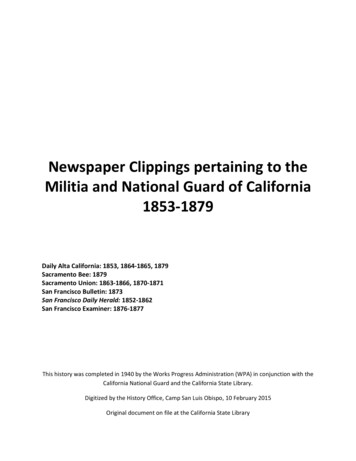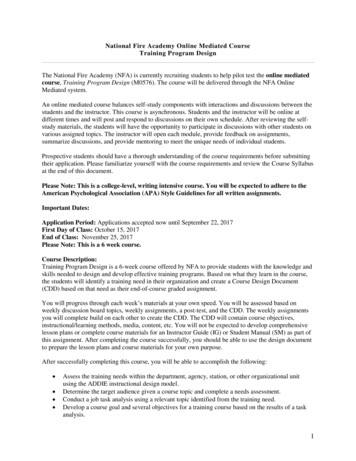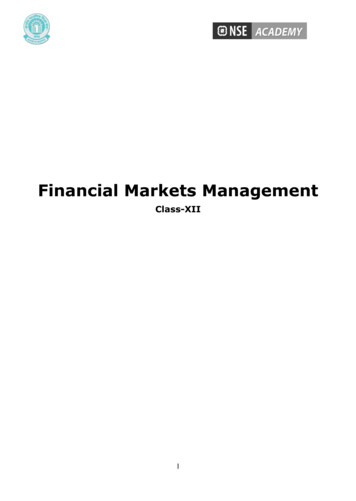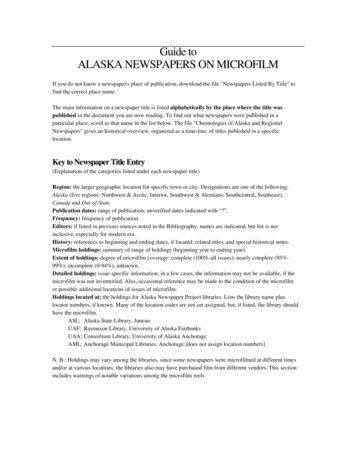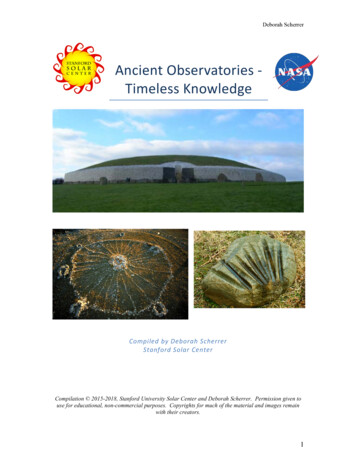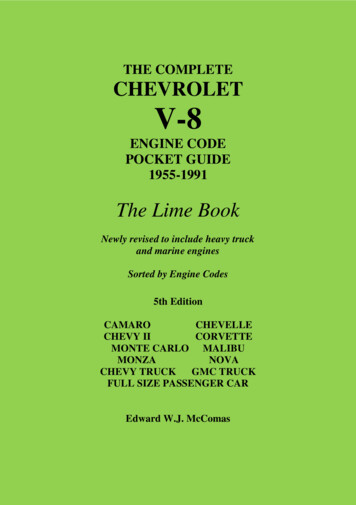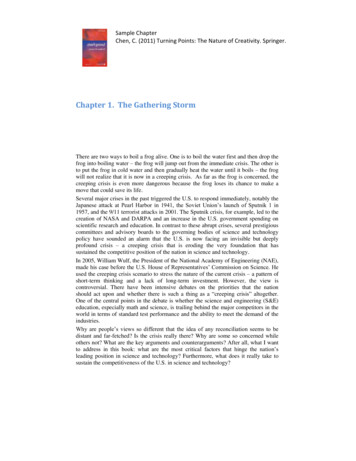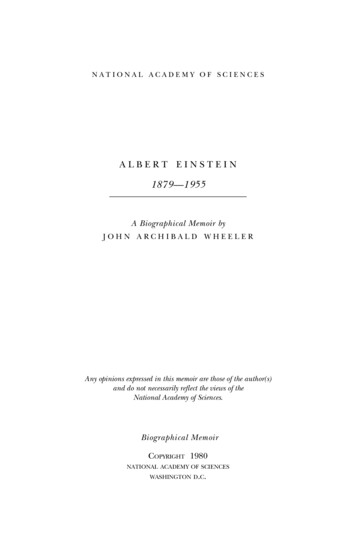
Transcription
national academy of sciencesAlbert Einstein1879—1955A Biographical Memoir byjohn archibald wheelerAny opinions expressed in this memoir are those of the author(s)and do not necessarily reflect the views of theNational Academy of Sciences.Biographical MemoirCopyright 1980national academy of scienceswashington d.c.
ALBERT EINSTEINMarch 14, 1879—April 18, 1955BY JOHN ARCHIBALD WHEELER*ALBERT EINSTEIN was born in Ulm, Germany on March-**- 14, 1879. After education in Germany, Italy, and Switzerland, and professorships in Bern, Zurich, and Prague, hewas appointed Director of Kaiser Wilhelm Institute for Physics in Berlin in 1914. He became a professor in the School ofMathematics at the Institute for Advanced Study in Princetonbeginning the fall of 1933, became an American citizen in thesummer of 1936, and died in Princeton, New Jersey on April18, 1955. In the Berlin where in 1900 Max Planck discoveredthe quantum, Einstein fifteen years later explained to us thatgravitation is not something foreign and mysterious actingthrough space, but a manifestation of space geometry itself.He came to understand that the universe does not go on fromeverlasting to everlasting, but begins with a big bang. Of allthe questions with which the great thinkers have occupiedthemselves in all lands and all centuries, none has everclaimed greater primacy than the origin of the universe, andno contributions to this issue ever made by any man anytimehave proved themselves richer in illuminating power thanthose that Einstein made.Einstein's 1915 geometrical and still standard theory of February 15, 1979.97
98BIOGRAPHICAL MEMOIRSgravity provides a prototype unsurpassed even today forwhat a physical theory should be and do, but for him it wasonly an outlying ridge in the arduous climb to a greater goalthat he never achieved. Scale the greatest Everest that thereis or ever can be, uncover the secret of existence—that waswhat Einstein struggled for with all the force of his life.How the mountain peak magnetized his attention he toldus over and over. "Out yonder," he wrote, "lies this hugeworld, which exists independently of us human beings andwhich stands before us like a great, eternal riddle. . . ."* Andagain, "The most incomprehensible thing about the world isthat it is comprehensible."t And yet again, "All of these endeavors are based on the belief that existence should have acompletely harmonious structure. Today we have lessground than ever before for allowing ourselves to be forcedaway from this wonderful belief." tWhen the climber laboring toward the Everest peakcomes to the summit of an intermediate ridge, he stops at thenew panorama of beauty for a new fix on the goal of his lifeand a new charting of the road ahead; but he knows that heis at the beginning, not at the end of his travail. What Einsteindid in spacetime physics, in statistical mechanics, and inquantum physics, he viewed as such intermediate ridges, suchway stations, such panoramic points for planning furtheradvance, not as achievements in themselves. Those way stations were not his goals. They were not even preplannedmeans to his goal. They were catch-as-catch-can means to hisgoal.Those who know physicists and mountaineers know thetraits they have in common: a "dream-and-drive" spirit, a*A. Einstein, "Autobiographical Notes," in Einstein: Philosopher-Scientist, ed. P. A.Schilpp (Evanston, 111.: Library of Living Philosophers, 1949), p. 4.t B . Hoffmann, Albert Einstein: Creator and Rebel (New York: Viking, 1972), p. 18.t A. Einstein, Essays in Science (New York: Philosophical Library, 1934), p. 114.
ALBERT EINSTEIN99bulldog tenacity of purpose, and an openness to try any routeto the summit. Who does not know Einstein's definition of ascientist as "an unscrupulous opportunist;"* or his words onanother occasion, "But the years of anxious searching in thedark, with their intense longing, their alternations of confidence and exhaustion, and the final emergence into thelight—only those who have experienced it can understandthat." f For such a man there are not goals. There is only thegoal, that distant peak.Who was this climber? How did he come to be bewitchedby the mountain? Where did he learn to climb so well? Whowere his companions? What were some of his adventures?And how far did he get?I first saw and heard Einstein in the fall of 1933, shortlyafter he had come to Princeton to take up his long-termresidence there. It was a small, quiet, unpublicized seminar.Unified field theory was to be the topic, it became clear, whenEinstein entered the room and began to speak. His English,though a little accented, was beautifully clear and slow. Hisdelivery was spontaneous and serious, with every now andthen a touch of humor. I was not familiar with his subject atthat time, but I could sense that he had his doubts about theparticular version of unified field theory he was then discussing. It was clear on this first encounter that Einstein wasfollowing very much his own line, independent of the interestin nuclear physics then at high tide in the United States.There was one extraordinary feature of Einstein the manI glimpsed that day, and came to see ever more clearly eachtime I visited his house, climbed to his upstairs study, and weexplained to each other what we did not understand. Over*A. Einstein, "Reply to Criticisms," in Einstein: Philosopher-Scientist, ed. P. A.Schilpp (Evanston, 111.: Library of Living Philosophers, 1949), p. 648.t M. J. Klein, Einstein, The Life and Times, R. W. Clark, book review, Science, 174:1315.
100BIOGRAPHICAL MEMOIRSand above his warmth and considerateness, over and abovehis deep thoughtfulness, I came to see, he had a unique senseof the world of man and nature as one harmonious andsomeday understandable whole, with all of us feeling our wayforward through the darkness together.Our last time together came twenty-one years later, onApril 14, 1954, when Einstein kindly accepted an invitation tospeak at my relativity seminar. It was the last talk he evergave, almost exactly a year before his death. He not onlyreviewed how he looked at general relativity and how he hadcome to general relativity, he also spoke as strongly as ever ofhis discomfort with the probabilistic features that thequantum had brought into the description of nature. "Whena person such as a mouse observes the universe," he askedfeelingly, "does that change the state of the universe?"* Healso commented in the course of the seminar that the laws ofphysics should be simple. One of us asked, "But what if theyare not simple?" "Then I would not be interested in them," the replied.How Einstein the boy became Einstein the man is a storytold in more than one biography, but nowhere better than inEinstein's own sketch of his life, so well known as to precluderepetition here. Who does not remember him in difficulty insecondary school, antagonized by his teacher's determinationto stuff knowledge down his throat, and in turn antagonizingthe teacher? Who that takes the fast train from Bern toZurich does not feel a lift of the heart as he flashes throughthe little town of Aarau? There, we recall, Einstein was sentto a special school because he could not get along in theordinary school. There, guided by a wise and kind teacher,*J. A. Wheeler, "Mercer Street and Other Memories," in Albert Einstein, HisInfluence on Physics, Philosophy, and Politics, ed. P. C. Aichelburg and R. U. Sexl(Braunscheig: Vieweg, 1979), p. 202.tlbid., p. 204.
ALBERT EINSTEIN101he could work with mechanical devices and magnets as wellas books and paper. Einstein was fascinated. He grew. Hesucceeded in entering the Zuricher Polytechnikum. One whowas a rector there not long ago told me that during his periodof rectorship he had taken the record book from Einstein'syear off the shelf. He discovered that Einstein had not beenthe bottom student, but next to the bottom student. And howhad he done in the laboratory? Always behind. He still didnot hit it off with his teachers, excellent teachers as he himselfsaid. His professor, Minkowski, later to be one of the warmestdefenders of Einstein's ideas, was nevertheless turned off byEinstein the student. Einstein frankly said he disliked lecturesand examinations. He liked to read. If one thinks of him aslonesome, one makes a great mistake. He had close colleagues. He talked and walked and walked and talked.To Einstein's development, his few close student colleagues meant much; but even more important were theolder colleagues he met in books. Among them were Leibnizand Newton, Hume and Kant, Faraday and Helmholtz,Hertz and Maxwell, Kirchhoff and Mach, Boltzmann andPlanck. Through their influence, he turned from mathematics to physics, from a subject where there are dismayinglymultitudinous directions for dizzy man to choose between, toa subject where this one and only physical world directs ourendeavors.Of all heroes, Spinoza was Einstein's greatest. No oneexpressed more strongly than he a belief in the harmony, thebeauty, and—most of all—the ultimate comprehensibility ofnature. In a letter to his old and close friend, Maurice Solovine, Einstein wrote, "I can understand your aversion to theuse of the term 'religion' to describe an emotional and psychological attitude which shows itself most clearly in Spinoza.[But] I have not found a better expression than 'religious' forthe trust in the rational nature of reality that is, at least to a
102BIOGRAPHICAL MEMOIRScertain extent, accessible to human reason."* In later years,Einstein was asked to do a life on Spinoza. He excused himself from writing the biography itself on the ground that itrequired "exceptional purity, imagination and modesty," tbut he did write the introduction. If it is true, as ThomasMann tells us, that each one of us models his or her lifeconsciously or unconsciously on someone who has gone before, then who was closer to being role-creator for Einsteinthan Spinoza?Search out the simple central principles of this physicalworld—that was becoming Einstein's goal. But how? Many aman in the street thinks of Einstein as a man who could onlymake headway in his work by dint of pages of complicatedmathematics; the truth is the direct opposite. As Hilbert putit, "Every boy in the streets of our mathematical Gottingenunderstands more about four-dimensional geometry thanEinstein. Yet, despite that, Einstein did the work and not themathematicians." Time and again, in the photoelectriceffect, in relativity, in gravitation, the amateur grasped thesimple point that had eluded the expert. Where did Einsteinacquire this ability to sift the essential from the non-essential?The management consultant firm of Booz, Allen &Hamilton, which does so much today to select leaders of greatenterprises, has a word of advice: What a young man doesand who he works with in his first job has more effect on hisfuture than anything else one can easily analyze. What wasEinstein's first job? In the view of many, the position of clerkin the Swiss patent office was no proper job at all, but it wasthe best job available to anyone with his unpromising university record. He served in the Bern office for seven years, from*A. Einstein, Lettres a Maurice Solovine (Paris: Gauthier-Villars, 1956), p. 102(January 1, 1956).t B . Hoffmann, Albert Einstein: Creator and Rebel (New York: Viking, 1972), p. 95.% P. Frank, Einstein, Sein Leben und seine Zeit (Miinchen: Paul List Verlag, 1949),p. 335.
ALBERT EINSTEIN103June 23, 1902 to July 6, 1909. Every morning he faced hisquota of patent applications. Those were the days when apatent application had to be accompanied by a workingmodel. Over and above the applications and the models wasthe boss, a kind man, a strict man, and a wise man. He gavestrict instructions: explain very briefly, if possible in a singlesentence, why the device will work or why it won't; why theapplication should be granted or why it should be denied.Day after day Einstein had to distill the central lesson out ofobjects of the greatest variety that man has power to invent.Who knows a more marvelous way to acquire a sense of whatphysics is and how it works? It is no wonder that Einsteinalways delighted in the machinery of the physicalworld—from the action of a compass needle to the meandering of a river, and from the perversities of a gyroscope to thedrive of Flettner's rotor ship.Whoever asks how Einstein won his unsurpassed power ofexpression, let him turn back to the days in the" patent officeand the boss who, "More severe than my father . . . taught meto express myself correctly." * The writings of Galileo arestudied in secondary schools in Italy today, not for theirphysics, but for their clarity and power of expression. Let thesecondary school student of our day take up the writings ofEinstein if he would see how to make in the pithiest way atelling point.From Bern, fate took Einstein to Zurich, to Prague, andthen to the Berlin where his genius flowered. Colleagueshipnever meant more in his life than it did during his 19 yearsthere, and never did he have greater colleagues: Max Planck,James Franck, Walter Nernst, Max von Laue, and others.Colleagueship did not mean chat; it meant serious consulta* "Errinerungen an Albert Einstein, 1902-1909," Bureau Federal de la ProprieteIntellectuelle (Berne, Switzerland), as quoted in: R. W. Clark, Einstein, The Life andTimes (New York: The World Publishing Co., 1971), p. 75.
104BIOGRAPHICAL MEMOIRStion on troubling issues. No tool of colleagueship was moreuseful than the seminar. James Franck explained to me thedemocracy of this trial by jury. The professor, he emphasized, stood on no pinnacle, beyond question by any student.On the contrary, the student had both the right and theobligation to question and to speak up.If the writing of letters is a test of colleagueship, let no onequestion Einstein's power to give and to receive. Consider hisenormous correspondence. Look at the postcards he sentover the years to the closest in spirit of all his colleagues, PaulEhrenfest in Leyden. They deal with the issues nearest to hisheart at the moment, whether the direction of time in statistical mechanics, or quantum fluctuations in radiation, or aproblem of general relativity. Or examine his correspondence with Max Born, or Maurice Solovine, or with everydaypeople. To a schoolgirl who mentioned among many otherthings her problems with mathematics, he replied, "Do notworry about your difficulties in mathematics; I can assureyou that mine are greater." * Why did Einstein correspond somuch with people that you and I would call outsiders? Did henot feel that the amateur brings a freshness of outlook unmatched by the specialist with his narrow view?The benefits of colleagueship with Einstein I experiencedmore than once, but never with greater immediate benefitthan in statistical mechanics. In a discussion of radiationdamping, he referred me to a published dialogue of 1909between himself and Walter Ritz. The two men agreed todisagree and stated their opposing positions in this singleclear sentence: "Ritz treats the limitations to retarded potentials as one of the foundations of the second law of thermodynamics, while Einstein believes that the irreversibility of radiation depends exclusively on considerations of probability." t* H. Dukas and B. Hoffmann, eds., Albert Einstein; The Human Side: New Glimpsesfrom His Archives (Princeton, N.J.: Princeton Univ. Press, 1979), p. 8.t A . Einstein and W. Ritz, Physikalisches Zeitschrift, 10 (1909): 323-34.
ALBERT EINSTEIN105In accord with the position of Einstein, Richard Feynmanand I found that the one-sidedness in time of radiation reaction can be understood as originating in the one-sidedness intime of the conditions imposed on the far-away absorberparticles, and not at all in the elementary law of interactionbetween particle and particle. I joined the ranks of what I canonly call "the worriers"—those like Boltzman, Ehrenfest, andEinstein himself, and many, many others—who ask, whyinitial conditions? Why not final conditions? Or why not somemixture of the two? And most of all, why thus and such initialconditions and no other? No one who knows of Einstein'slifelong concern with such issues can fail to have a new senseof appreciation on reading his great early papers on statisticalmechanics, and not least among them the famous 1905 paperon the theory of the Brownian motion. Surely the perspectivehe won from these worries will someday help show us the wayto Everest. "Best known of Einstein's great trio of 1905 papers,however, is that on special relativity. "Henceforth," asMinkowski put the lesson of Einstein, "space by itself andtime by itself, are doomed to fade away into mere shadows,and only a kind of union of the two will preserve an independent reality."* Historians of science can tell us that if Einsteinhad not come to this version of spacetime it would have beenachieved by Lorentz, or Poincare, or another, who would alsohave come eventually to that famous equation E me2, withall its consequences. But it still comes to us as a miracle thatthe patent office clerk was the one to deduce this greatest oflessons about spacetime from clues on the surface so innocentas those afforded by electricity and magnetism. Miracle?Would it not have been a greater miracle if anyone but apatent office clerk had discovered relativity? Who else couldhave distilled this simple central point from all the clutter of*C. Reid, Hilbert (Berlin: Springer, 1970), p. 12.
106BIOGRAPHICAL MEMOIRSelectromagnetism than someone whose job it was over andover each day to extract simplicity out of complexity?If others could have given us special relativity, who elsebut Einstein, sixty-four years ago, could have given us general relativity? Who else knew out of the welter of facts tofasten on that which is absolutely central? Did the centralpoint come to him, as legend has it, from talking to a housepainter who had fallen off a roof and reported feelingweightless during the fall? We all know that he called that1908 insight the "happiest thought of my life"*—the ideathat there is no such thing as gravitation, only free-fall. Bythus giving up gravitation, Einstein won back gravitation as amanifestation of a warp in the geometry of space. His 1915and still standard geometric theory of gravitation can be summarized, we know today, in a single, simple sentence: "Spacetells matter how to move and matter tells space how tocurve." t Through his insight that there is no such thing asgravity, he had had the creative imagination to bring togethertwo great currents of thought out of the past. Riemann hadstressed that geometry is not a God-given perfection, but apart of physics; and Mach had argued that accelerationmakes no sense except with respect to frame determined bythe other masses in the universe.It is unnecessary to recall the three famous early tests ofEinstein's geometric theory of gravitation: the bending oflight by the sun, the red-shift of light from the sun, and theprecession of the orbit of the planet Mercury going aroundthe sun. Neither is it necessary to expound the importantinsights that have come and continue to come out of generalrelativity. Einstein showed that the law for the motion of amass in space and time does not have to be made a separate* A. Einstein, "The Fundamental Idea of General Relativity in Its Original Form,"unpublished essay, 1919 (excerpts, New York Times, 28 March 1972), p. L.32.fj. A. Wheeler, University of Texas, lecture of 2 March 1979.
ALBERT EINSTEIN107item in the conceptual structure of physics. Instead, it comesstraight out of geometric law as applied to the space immediately surrounding the mass in question. Moreover, the geometry that he had freed from slavery to Euclid, and that he hadassigned to carry gravitation force, could throw off its chains,become a free agent, and, under the name of "gravitationalradiation," carry energy from place to place over and aboveany energy carried by electromagnetic waves—an effect forwhich Joseph H. Taylor, L. A. Fowler, P. M. McCulloch, andtheir Arecibo Observatory colleagues in December 1978 announced impressive evidence.*One does not need to go into the theory of gravitationallycollapsed objects or the evidence we have today, some impressive, some less convincing, for black holes: one of someten solar masses in the constellation Cygnus; others in therange of a hundred or a thousand solar masses at the centersof five of the star clusters in our galaxy; one about fourmillion times as massive as the sun at the center of the MilkyWay; and one with a mass of about five billion suns in thecenter of the galaxy M87.The collapse at the center of a black hole marks a third"gate of time," f additional to the big bang and the big crunch.Einstein tried to escape all three. Two years after generalrelativity, Einstein was already applying it to cosmology. Hegave reasons to regard the universe as closed and qualitatively similar to a three sphere, the three-dimensional generalization of the surface of a rubber balloon. To his surprise,he found that the universe is dynamic and not static.Einstein could not accept this result. First, he found fault*L. A. Fowler, P. M. McCulloch, and J. H. Taylor, "Measurement of GeneralRelativistic Effects in the Binary Pulsar PSR 1913 16," Nature, 277 (8 February1979)437-40.t j . A. Wheeler, "Genesis and Observership," mFoundational Problems in the SpecialSciences, ed. R. E. Butts and K. J. Hintikka (Reidel: Dordrecht, 1977), p. 11.
108BIOGRAPHICAL MEMOIRSwith Alexander Friedmann's mathematics. Then he retractedthis criticism, and looked for the fault in his own theory ofgravitation. It turned out there was no natural way to changethat theory. The arguments of simplicity and correspondence in the appropriate limit with the Newtonian theory ofgravitation left no alternative. There being no natural way tochange the theory, he looked for the least unnatural way hecould find to alter it. He introduced a so-called "cosmologicalterm" with the sole point and purpose to hold the universestatic. A decade later, Edwin Hubble, working at Mount Wilson Observatory, gave convincing evidence that the universeis actually expanding. Thereafter, Einstein remarked that thecosmological term "was the biggest blunder of my life."*Today, looking back, we can forgive him his blunder and givehim the credit for the theory of gravitation that predicted theexpansion. Of all the great predictions that science has evermade over the centuries, each of us has his own list of spectaculars, but among them all was there ever one greater thanthis, to predict, and predict correctly, and predict against allexpectation, a phenomenon so fantastic as the expansion ofthe universe? When did nature ever grant man greater encouragement to believe he will someday understand the mystery of existence?Why did Einstein in the beginning reject his own greatestdiscovery? Why did he feel that the universe should go onfrom everlasting to everlasting, when to all brought up in theJudeo-Christian tradition an original creation is the naturalconcept? I am indebted to Professor Hans Kiing for suggesting an important influence on Einstein from his hero Spinoza. Why was twenty-four-year-old Spinoza excommunicated in 1656 from the synagogue in Amsterdam? Because hedenied the doctrine of an original creation. What was the*G. Gamow, My World Line (New York: Viking, 1970), p. 44.
ALBERT EINSTEIN109difficulty with that doctrine? In all that nothingness beforecreation where could that clock sit that should tell the universe when to come into being!Today we have a little less difficulty with this point. We donot escape by saying that the universe goes through cycleafter cycle of big bang and collapse, world without end.There is not the slightest warrant in general relativity forsuch a way of speaking. On the contrary, it provides no placewhatsoever for a before before the big bang or an after afterthe big crunch. Quantum theory goes further. It tells us thathowever permissible it is to speak about space, it is not permissible to speak in other than approximate terms of spacetime. To do so would violate the uncertainty principle—asthat principle applies to the dynamics of geometry. No, whenit comes to small distances either in the here and the now orin the most extreme stages of gravitational collapse, spacetime loses all meaning, and time itself is not an ultimatecategory in the description of nature. No one who wrestleswith the three gates of time, our greatest heritage ofparadox—and of promise—from general relativity canescape the all-pervasive influence of the quantum.Spinoza's influence on his thinking about cosmology Einstein could shake off—but not Spinoza's deterministic outlook. Proposition XXIX in The Ethics of Spinoza states:"Nothing in the universe is contingent, but all things areconditioned to exist and operate in a particular manner bythe necessity of divine nature."* Einstein accepted determinism in his mind, his heart, his very bones.Who then was first clearly to recognize that the real world,and the world of the quantum, is a world of chance andunpredictability? Einstein himself!Why did Einstein, who in the beginning with Max Planck* B. Spinoza, Die Ethik, Part One, Proposition XXIX (Hamburg: F. Meiner, 1955).
110BIOGRAPHICAL MEMOIRSand Niels Bohr had done so much to give quantum physics tothe world, in the end stand out so strongly and so lonesomelyagainst the central point? What other explanation is therethan this "set" he had received from Spinoza?The early quantum work of Bohr and Einstein is almosta duet. Einstein, 1905: The energy of light is carried fromplace to place as quanta of energy, accidental in time andspace in their arrival. Bohr, 1913: The atom is characterizedby stationary states, and the difference in energy between oneand another is given off in a light quantum. Einstein, 1916:The processes of light emission and light absorption are governed by the laws of chance, but satisfy the principle ofdetailed balance. Bohr, 1927: Complementarity prevents adetailed description in space and time of what goes on in theact of emission. Here Bohr and Einstein parted company.Einstein spoke against Einstein. The Einstein who in 1915said there was no escape from the laws of chance was insistingby 1916, as he did all the rest of his life, against the evidenceand against the views of his greatest colleagues, that "Goddoes not [play] dice." *If an army is being defeated it can still, by a sufficientlyskillful rear-guard action, have an important influence on theoutcome. No one who in all the great history of the quantumcontested with Niels Bohr did more to sharpen andstrengthen Bohr's position than Einstein. Never in recentcenturies was there a dialogue between two greater men overa longer period on a deeper issue at a higher level of colleagueship, nor a nobler theme for playwright, poet, or artist.From their earliest encounter, Einstein liked Bohr, writinghim on May 2, 1920, "I am studying your great works—andwhen I get stuck anywhere—now have the pleasure of seeingyour friendly young face before me smiling and explain*A. Einstein, Albert Einstein und Max Born, Bnefwechsel, 1916-1955, Kommentiert vonMax Born (Munchen: Nymphenburg, 1969), pp. 129-30.
ALBERT EINSTEIN111ing."* Bohr viewed Einstein with admiration and warm regard. Let him who will read Bohr's account of the famousdialogue, even today unsurpassed for its comprehensive articulation of the central issues. Who knows what the quantummeans who does not know the friendly but deadly seriousbattles fought and won on the double-slit experiment, on thepossibilities for weighing a photon, on the Einstein-PodolskyRosen experiment, and on the danger associated withunguarded use of the word "reality"? To help to clarify theissues brought up in the later years of the great dialogue,Bohr found himself forced to introduce the word "phenomenon" f to describe an elementary quantum process "broughtto a close by an irreversible act of amplification." Thanks tothat word, brought in to withstand the criticism of Einstein,we have learned in our own time to state the central lesson ofthe quantum in a single simple sentence, "No elementaryphenomenon is a phenomenon until it is an observed phenomenon." §How could the correctness of quantum theory be by nowso widely accepted, and its decisive point so well perceived, ifthere had been no great figure, no Einstein, to draw theembers of unease together in a single flame and thereby driveBohr to that fuller formulation of the central lesson which heat last achieved?If the quantum and the gates of time are the strongestfeatures of this strange universe, and if they shall prove intime to come the doorways to that deeper view for which* Letter to N. Bohr, 2 May 1920.t N. Bohr, "Discussion with Einstein on Epistemological Problems in Atomic Physics," in Einstein: Philosopher-Scientist, ed. P. A. Schilpp (Evanston, 111.: Library ofLiving Philosophers, 1949), p. 238.t N. Bohr, Atomic Physics and Human Knowledge (New York: Wiley, 1958), p. 73, 88.§J. A. Wheeler, "Frontiers of Time," in Rendicotti delta Scuola Internazionale diFisica "Enrico Fermi," LXXII Corso, Problems in the Foundations of Physics, ed. N.Toraldo di Francia and Bas van Fraassen (Amsterdam: North-Holland, 1979), pp.395 197.
112BIOGRAPHICAL MEMOIRSEinstein searched, mankind will forever remember withgratitude his absolutely decisive involvement with both.No one who is a professor and receives his support fromthe larger community can rightly be unmindful of his obligations to it. He must speak to the higher values of all insofaras he is qualified and able to do so. Burden though it was forEinstein to take on this extra duty, he did it to the best of hisability. What he defended were no whims, no lightly heldfancies, but goals he held and deeply desired for the world.If in
as books and paper. Einstein was fascinated. He grew. He succeeded in entering the Zuricher Polytechnikum. One who was a rector there not long ago told me that during his period of rectorship he had taken the record book from Einstein's year off the shelf. He discovered that Einstein had not been the bottom student, but next to the bottom .

